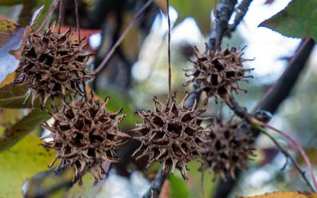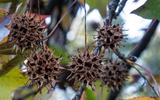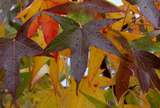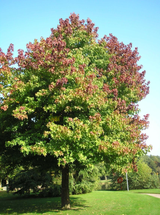- 2024 Native Trees
- >
- Native Trees
- >
- Sweetgum (Liquidamber styracifula)
Sweetgum (Liquidamber styracifula)
Height: 60 to 80 feet
Spread: 40 to 60 feet
Sun: Full sun to part shade
Suggested Use: Shade Tree
Fruit: Showy
Maintenance: Low
Tolerate: Deer, Clay Soils, Black Walnut
Leaf: Great Fall Color of Yellow, Purple, Orange, and Red
So much a star of the landscape the leaves of the Sweetgum show it to be true while the fruit beckons for the tree to be added within the potpourri of the diverse plantings.
George Washington planted Sweetgums trees throughout his Mount Vernon farms and highly regarded the tree for its beauty and multitude of uses. When his treasury secretary, Alexander Hamilton, visited Mount Vernon, Washington gave Hamilton thirteen Sweetgum whips which were planted in a tight grove outside his home in New York City.
This low maintenance tree is a nice and showy tree that stands out in the landscape. It has a pyramidal growth with a single straight trunk. The branches when young have a corky and winged liked texture that is quite noticeable. The tree has a shallow root system that can protrude from the ground, giving it unique texture and focal points from the ground up. The leaves are star shaped with 5 to 7 points and when bruised are fragrant and unappealing to deer.
Sweetgums are probably most noted for their gum balls. The hard bristly fruiting clusters are about 1-2 inches in diameter and mature to a dark brown. The gum balls often persist through winter and provide winter interest. Most potpourri mixes include the textured gumballs.
The tree has a wide variety of uses. Sweetgum is second in production to oaks among the hardwoods. The wood is heavy, moderately hard, and close grained and used for furniture, cabinetwork, veneer, plywood, pulpwood, barrels, and boxes. It is not durable upon exposure. Whereas the fragrant sap and resin obtained from the sap of the wood has been used as a chewing gum, incense, perfume, natural medicine, and flavoring for drinks and food.
This plant is an important host species and supports Imperial Moth larvae which have one brood per season. Sweetgum also supports Hickory Horndevil which have one brood and appear from May to mid-September. Adult Hickory Horndevil moths do not feed. Songbirds, like the American goldfinch eat the seeds during the winter. The tree is a host plant for 19 species of butterflies and moths in the Jefferson County. ■






